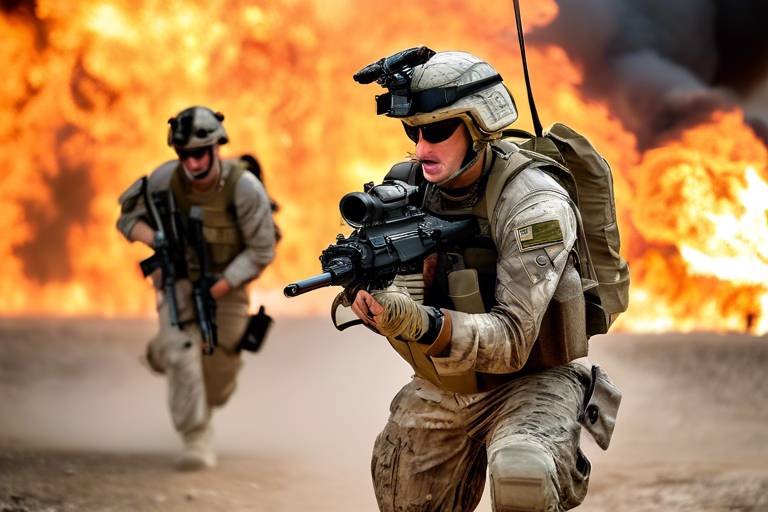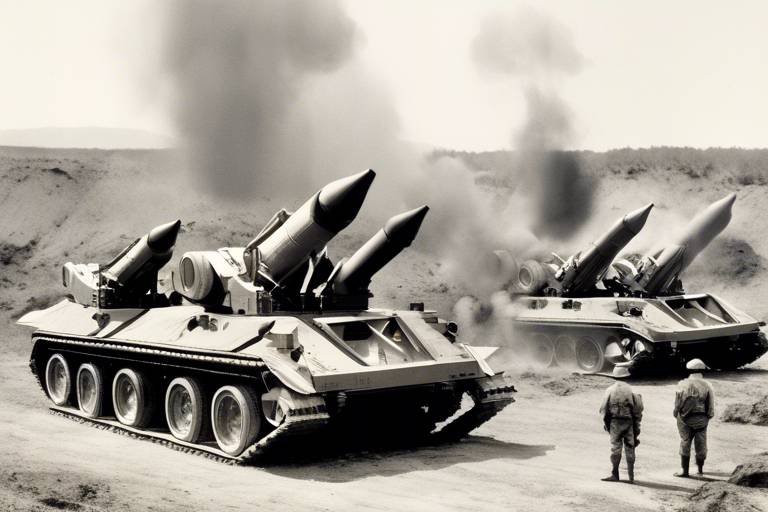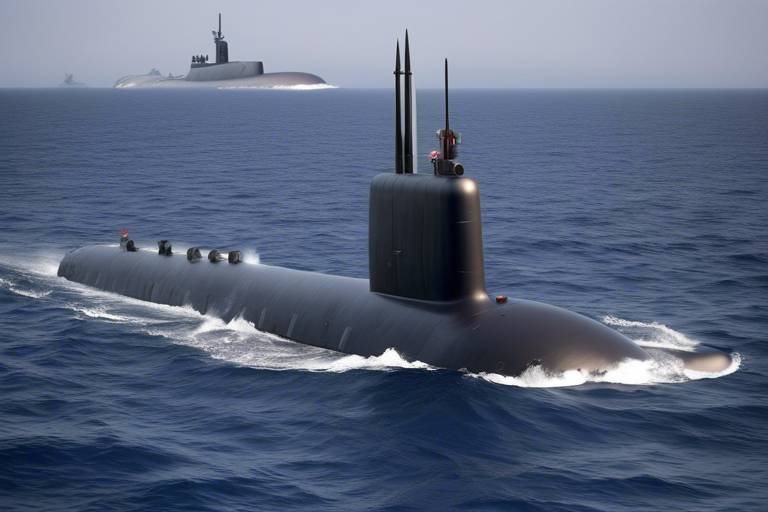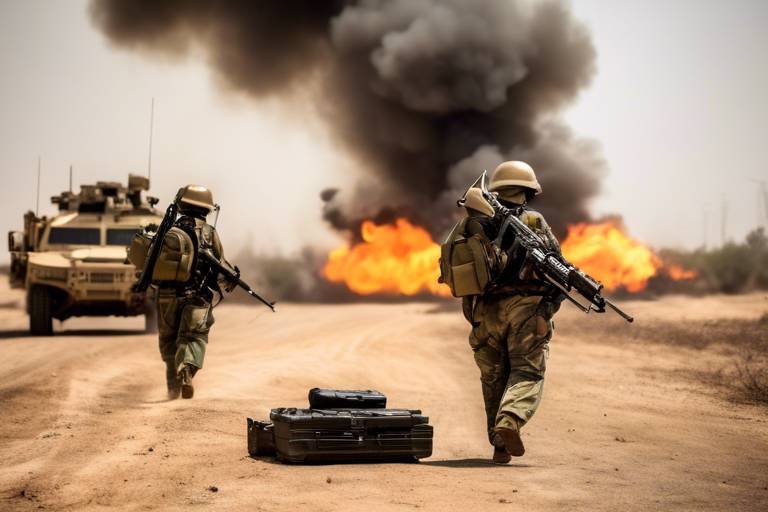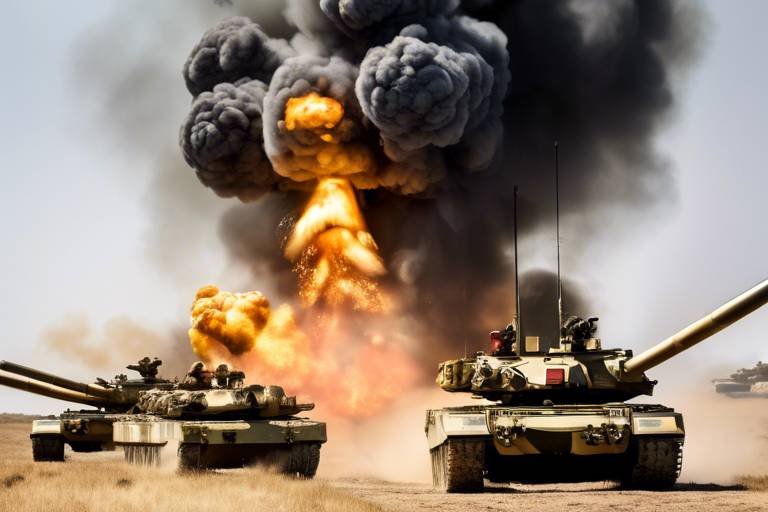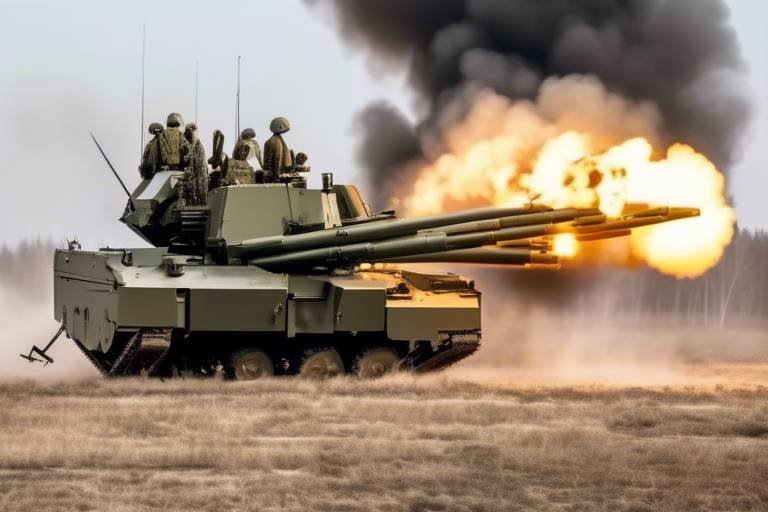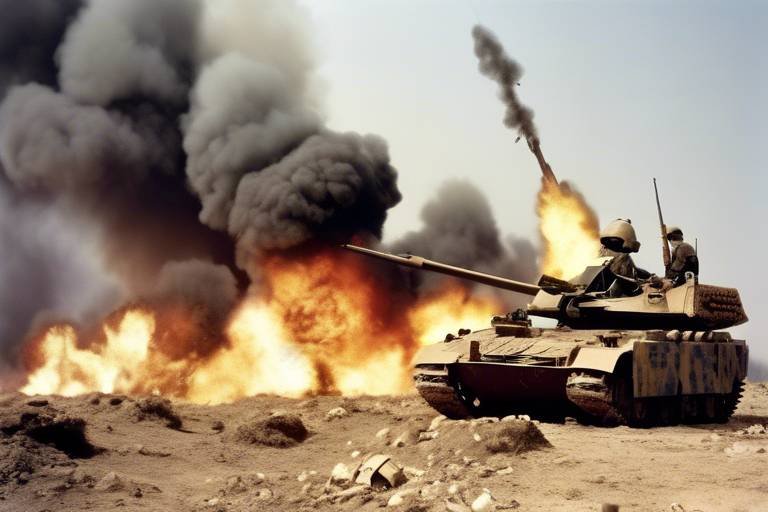How Firepower is Adapted for Counter-Narcotics Operations
In the ever-evolving battle against drug trafficking, the adaptation of firepower has become a cornerstone of counter-narcotics operations. With drug cartels becoming increasingly sophisticated, law enforcement and military forces are compelled to innovate and enhance their strategies. The use of firepower in this context is not just about sheer strength; it’s about precision, timing, and the ability to outmaneuver adversaries who often possess advanced weaponry themselves. Imagine a chess game where each move could mean the difference between life and death. That’s the reality for those engaged in these high-stakes operations.
Firepower in counter-narcotics serves multiple roles, from deterring potential threats to engaging in direct confrontations with heavily armed traffickers. The stakes are incredibly high, as drug trafficking not only endangers communities but also fuels violence and corruption. Therefore, the effective adaptation of firepower is crucial to ensuring that law enforcement agencies can protect citizens while dismantling these criminal networks. Think of it as a finely tuned orchestra where each instrument must play its part perfectly to create a harmonious outcome.
Moreover, the integration of advanced technologies into firepower adaptation has revolutionized how operations are conducted. Drones equipped with surveillance capabilities, for instance, have transformed the landscape of intelligence gathering. They provide real-time data that can be crucial for planning operations and executing them with surgical precision. This technology allows for the identification of drug production sites and trafficking routes without putting personnel in harm's way. The evolution of weaponry—ranging from precision-guided munitions to non-lethal options—illustrates how adaptable and innovative counter-narcotics strategies have become.
However, it’s not just about having the latest gadgets or firepower. The human element remains vital. Training personnel to effectively utilize these advanced tools is equally important. Just as a skilled chef knows how to use each utensil in their kitchen, law enforcement must be adept at using their resources to maximize effectiveness in the field. The combination of technology and skilled operators creates a formidable force against drug trafficking, enhancing both operational efficiency and safety.
As we delve deeper into the specifics of how firepower is adapted for counter-narcotics operations, it’s essential to recognize the collaborative efforts that underpin these strategies. Military and law enforcement agencies must work hand-in-hand, sharing intelligence and resources to ensure a unified front against drug cartels. This collaboration not only enhances operational success but also fosters a sense of community and trust among the agencies involved.
In summary, the adaptation of firepower for counter-narcotics operations is a multi-faceted approach that combines technology, training, and collaboration. It’s a dynamic field that requires constant evolution to keep pace with the ever-changing tactics of drug traffickers. By understanding and implementing these strategies, law enforcement agencies can better protect communities from the pervasive threat of narcotics.
- What role does technology play in counter-narcotics operations?
Technology, especially in the form of drones and advanced weaponry, enhances the effectiveness of counter-narcotics operations by providing real-time intelligence and precision targeting capabilities.
- How do law enforcement and military agencies collaborate in these operations?
Collaboration occurs through joint task forces that combine resources and expertise, leading to more successful operations against drug trafficking organizations.
- What are the legal and ethical considerations in using firepower?
Legal and ethical considerations include establishing clear rules of engagement to ensure responsible use of firepower, as well as understanding the community impact to maintain trust with local populations.
The Role of Firepower in Counter-Narcotics
Firepower is not just a buzzword in military and law enforcement circles; it represents a critical component in the ongoing battle against drug trafficking. The stakes are incredibly high, as drug cartels wield significant influence and power, often outgunning local law enforcement. In such a volatile environment, having the right firepower can mean the difference between a successful operation and a catastrophic failure. This is why understanding the role of firepower in counter-narcotics is vital for both strategy and execution.
At its core, firepower serves multiple purposes in counter-narcotics operations. First and foremost, it acts as a deterrent. When drug traffickers know that authorities are equipped with advanced weaponry, they may think twice before engaging in violent confrontations. This is especially important in regions where drug-related violence is rampant. Additionally, firepower provides the capability to engage in direct confrontations when necessary, ensuring that law enforcement can protect themselves and the communities they serve.
Moreover, firepower enhances operational efficiency. With the right tools, law enforcement agencies can conduct raids, monitor drug production sites, and intercept shipments more effectively. For instance, a well-equipped tactical unit can execute a raid with precision, minimizing risks to civilians while maximizing the chances of apprehending suspects. The use of advanced weaponry, such as non-lethal options, also allows for a more measured approach, reducing the potential for collateral damage.
To illustrate the importance of firepower, consider the following table that outlines key aspects of firepower in counter-narcotics operations:
| Aspect | Description |
|---|---|
| Deterrence | Discourages drug traffickers from engaging in violent confrontations. |
| Operational Efficiency | Enhances the ability to conduct raids and monitor drug activities. |
| Community Protection | Ensures the safety of civilians during operations. |
| Precision Targeting | Allows for focused actions against specific threats. |
However, it’s essential to recognize that firepower is not a standalone solution. It must be integrated with intelligence, strategy, and community engagement. For example, while having superior firepower can provide an advantage, it’s the intelligence gathered from local communities that often leads to successful operations. This creates a synergistic effect where firepower, intelligence, and community trust work hand in hand to combat drug trafficking effectively.
In conclusion, the role of firepower in counter-narcotics operations cannot be overstated. It serves as a crucial tool that not only deters drug traffickers but also enhances the operational capabilities of law enforcement. However, it must be wielded responsibly, with a focus on community safety and engagement. The fight against drug trafficking is complex, and firepower is just one piece of the puzzle, albeit an essential one.
Technological Advancements in Weaponry
In the ever-evolving landscape of counter-narcotics operations, technological advancements in weaponry have played a pivotal role in enhancing the effectiveness of law enforcement and military efforts against drug trafficking. Gone are the days when traditional firearms were the only tools available for combating heavily armed drug cartels. Today, a blend of cutting-edge technology and tactical innovation has transformed the battlefield, allowing operatives to engage in more precise and efficient operations.
One of the most significant advancements has been the integration of smart technology into weapon systems. This includes features such as targeting systems that utilize artificial intelligence to improve accuracy and reduce the risk of collateral damage. For instance, modern firearms can be equipped with laser-guided sights and ballistic computers that calculate the trajectory of a bullet based on environmental conditions, ensuring that every shot counts. This level of precision is crucial when engaging in operations where innocent lives may be at stake.
Moreover, the development of non-lethal weaponry has also gained traction in counter-narcotics efforts. Tools such as rubber bullets, tear gas, and electronic control devices provide law enforcement with alternatives to lethal force, allowing them to incapacitate suspects without causing permanent harm. This approach not only aligns with ethical considerations but also helps maintain community trust, which is vital for successful operations.
When discussing technological advancements, we cannot overlook the impact of drones in counter-narcotics operations. These unmanned aerial vehicles (UAVs) have revolutionized the way intelligence is gathered and operations are conducted. Equipped with high-resolution cameras and thermal imaging, drones provide real-time surveillance, enabling operatives to monitor drug production facilities and trafficking routes from a safe distance.
Furthermore, drones can be armed with precision munitions, allowing for targeted strikes against drug labs or transport vehicles. This capability minimizes the risk to ground troops and reduces the likelihood of civilian casualties. However, the integration of drones into operations is not without its challenges, including regulatory hurdles and the need for skilled operators who can navigate complex airspace regulations.
Equipping drones with advanced weaponry and surveillance equipment enhances their effectiveness significantly. For instance, drones can be outfitted with high-powered cameras and sensor technology that can detect heat signatures, making it easier to locate hidden drug production sites. Additionally, the ability to deploy explosive ordnance from a drone allows for surgical strikes that can dismantle drug trafficking operations with minimal risk to personnel on the ground.
Despite their advantages, the use of drones in counter-narcotics operations faces several challenges. Regulatory restrictions can limit their deployment, and there is an ongoing debate about the ethical implications of using drones for combat purposes. Moreover, the need for skilled operators cannot be overstated; without trained personnel, the potential of these technological advancements cannot be fully realized.
In conclusion, the technological advancements in weaponry have significantly enhanced the capabilities of forces involved in counter-narcotics operations. From smart firearms to the strategic use of drones, these innovations allow for more effective engagement against drug traffickers while also considering the ethical implications of their use. As we continue to adapt to the changing dynamics of drug trafficking, the integration of technology will undoubtedly remain a cornerstone of operational success.
Drones and Aerial Surveillance
In the realm of counter-narcotics operations, drones have emerged as a game-changer, revolutionizing the way authorities gather intelligence and conduct operations. Imagine having a bird's-eye view of a vast area, capable of spotting illicit activities that would be nearly impossible to detect from the ground. This capability not only enhances surveillance but also allows for rapid response to threats posed by drug traffickers. Drones equipped with high-resolution cameras and advanced sensors can monitor remote locations, providing real-time data that is crucial for decision-making.
The integration of aerial surveillance into counter-narcotics strategies has proven effective in various scenarios. For instance, drones can fly over known drug production zones, capturing detailed imagery that reveals hidden fields or clandestine labs. This information can then be analyzed to determine the scale of operations and the necessary tactical responses. Furthermore, the ability to operate in challenging terrains, such as mountainous regions or dense jungles, makes drones an invaluable asset in areas where traditional ground forces might struggle to navigate.
Equipping drones with advanced technologies has significantly enhanced their effectiveness. Many modern drones are fitted with infrared cameras that can detect heat signatures, making it easier to identify illegal activities even at night. Additionally, the incorporation of GPS tracking and real-time data transmission capabilities means that operators can monitor activities as they unfold, allowing for timely interventions. This technological prowess not only improves the accuracy of operations but also helps in minimizing collateral damage, a critical consideration in sensitive counter-narcotics missions.
However, the use of drones in counter-narcotics operations is not without its challenges. Regulatory restrictions often limit the deployment of drones, particularly in urban areas where privacy concerns are paramount. Moreover, the need for skilled operators who can effectively manage these sophisticated systems adds another layer of complexity. Training personnel to handle drones and interpret the data they gather is essential for maximizing their potential. Without proper training, the advantages that drones offer could be underutilized, rendering them less effective in the fight against drug trafficking.
In conclusion, drones and aerial surveillance are reshaping the landscape of counter-narcotics operations. Their ability to provide real-time intelligence, coupled with advanced technological features, makes them indispensable tools in the ongoing battle against drug trafficking. As authorities continue to adapt and innovate, the role of drones is likely to expand, further enhancing operational efficiency and effectiveness in combatting narcotics-related threats.
Equipping Drones for Combat
Equipping drones for combat in counter-narcotics operations is a game-changer, transforming the way law enforcement and military forces engage with drug trafficking organizations. Imagine a bird's-eye view of the battlefield, where operators can monitor movements, detect illicit activities, and strike with precision. Drones, once mere toys for tech enthusiasts, have evolved into sophisticated tools of warfare, boasting advanced capabilities that enhance operational efficiency.
At the heart of this transformation lies a range of specialized equipment tailored for combat scenarios. These enhancements are not just about firepower; they also focus on intelligence gathering and surveillance. For instance, drones can be outfitted with high-resolution cameras, infrared sensors, and even advanced radar systems that detect hidden drug production facilities. This multi-faceted approach allows for a comprehensive understanding of the operational landscape, enabling tactical decision-making that was previously unimaginable.
Moreover, the integration of weaponry into drones has taken counter-narcotics operations to the next level. Drones can be equipped with precision-guided munitions, allowing them to engage targets with minimal collateral damage. This capability is crucial in urban environments, where the risk of harming innocent civilians is a significant concern. By utilizing drones for targeted strikes, law enforcement can disrupt drug trafficking operations without escalating violence on the ground.
However, equipping drones for combat is not without its challenges. The technology is constantly evolving, and so are the tactics employed by drug traffickers. To stay ahead, operators must undergo rigorous training to effectively utilize these advanced systems. Additionally, the legal framework surrounding drone usage in combat scenarios remains a gray area, requiring agencies to navigate a complex landscape of regulations and ethical considerations.
In summary, the adaptation of drones for combat in counter-narcotics operations represents a significant leap forward in the fight against drug trafficking. With the right equipment and training, these aerial vehicles can provide a strategic advantage, enabling forces to carry out their missions with greater efficiency and precision. As technology continues to advance, the potential for drones in this arena is bound to expand, paving the way for even more innovative approaches in the ongoing battle against narcotics.
Challenges of Drone Usage
While drones have revolutionized the landscape of counter-narcotics operations, their implementation is not without its challenges. One of the primary hurdles is the regulatory restrictions that govern the use of unmanned aerial vehicles (UAVs). Different countries have varying laws regarding airspace, privacy, and the deployment of drones in combat scenarios. This patchwork of regulations can create significant obstacles for agencies trying to coordinate effective drone operations across borders.
Moreover, the need for skilled operators cannot be overstated. Operating drones effectively requires a level of expertise that not all personnel possess. Training programs can be resource-intensive and time-consuming, which can delay the deployment of these advanced systems in urgent situations. The complexity of drone technology means that even minor mistakes in operation can lead to catastrophic outcomes, including unintended casualties or collateral damage.
Another challenge is the risk of technological failure. Drones, like any piece of technology, can malfunction. Factors such as weather conditions, battery life, and software glitches can compromise missions. For instance, a drone may lose signal or crash during a critical surveillance operation, jeopardizing the entire mission and potentially alerting traffickers to law enforcement's presence.
Additionally, the ethical implications of drone usage in counter-narcotics operations must be considered. The ability to conduct strikes from a distance can desensitize operators to the human impact of their actions. This detachment raises questions about accountability and the moral responsibility of those who deploy these technologies. How do we ensure that firepower is used judiciously and in accordance with established rules of engagement?
Lastly, the community perception of drone usage can be a double-edged sword. While drones can enhance operational efficiency, they can also instill fear within local populations. Communities may view their presence as an invasion of privacy or as a sign of escalating violence, which can strain relationships between law enforcement and the very communities they aim to protect. It is vital to engage with these communities, educating them about the purpose and benefits of drone operations to foster trust and cooperation.
In summary, while drones offer remarkable capabilities in counter-narcotics operations, the challenges associated with their usage necessitate careful consideration and planning. Addressing regulatory hurdles, ensuring skilled operation, managing technological risks, contemplating ethical implications, and maintaining positive community relations are all critical to harnessing the full potential of drones in the fight against drug trafficking.
Small Arms and Tactical Gear
When it comes to counter-narcotics operations, the choice of small arms and tactical gear is absolutely critical. Imagine trying to tackle a highly organized drug cartel armed with sophisticated weaponry while your team is left with outdated firearms and inadequate protective gear. It’s like bringing a knife to a gunfight! The stakes are high, and the personnel involved need to be equipped with the best tools available to ensure their safety and operational success.
Small arms, which include handguns, rifles, and submachine guns, are the frontline weapons for ground forces. These weapons must be reliable, accurate, and easy to handle. For instance, modern rifles like the M4 Carbine or the AK-47 provide not only firepower but also versatility in various combat situations. The choice of caliber is also significant; a weapon chambered in a high-velocity round can deliver the necessary stopping power against heavily armed adversaries.
On the other hand, tactical gear encompasses a wide range of equipment designed to enhance the effectiveness and safety of personnel in the field. This includes body armor, helmets, and communication devices. The integration of advanced materials such as Kevlar into body armor has revolutionized personal protection, allowing operatives to withstand small arms fire while maintaining mobility. Additionally, night vision goggles and thermal imaging devices have become essential tools, enabling forces to operate effectively in low-light or obscured conditions.
Moreover, the importance of communication systems cannot be overstated. In the chaotic environment of a counter-narcotics operation, clear and reliable communication can mean the difference between success and failure. Modern tactical communication devices allow for encrypted messaging, ensuring that sensitive information is kept secure from prying eyes.
Here’s a brief comparison table highlighting some key small arms and tactical gear used in counter-narcotics operations:
| Equipment | Purpose | Key Features |
|---|---|---|
| M4 Carbine | Assault Rifle | Lightweight, modular, effective range up to 600 meters |
| Glock 19 | Handgun | Compact, reliable, 15-round magazine capacity |
| Ballistic Vest | Body Armor | Multi-hit capability, lightweight, adjustable fit |
| Night Vision Goggles | Visibility Enhancement | Allows for clear vision in darkness, lightweight |
In conclusion, the selection of small arms and tactical gear is not just a matter of preference; it is a necessity that directly impacts the success of counter-narcotics operations. With the right equipment, personnel can engage effectively with drug traffickers, ultimately leading to safer communities and more successful missions.
- What types of small arms are preferred in counter-narcotics operations? The M4 Carbine and Glock 19 are commonly used due to their reliability and effectiveness.
- How does tactical gear enhance operational success? Tactical gear such as body armor and communication devices improves personnel safety and coordination during operations.
- Are there specific training requirements for using these weapons and gear? Yes, personnel must undergo extensive training to effectively utilize small arms and tactical gear in various scenarios.
Collaborative Efforts with Law Enforcement
When it comes to tackling the complex issue of drug trafficking, collaboration between military forces and law enforcement agencies is not just beneficial; it's essential. Imagine trying to solve a jigsaw puzzle where the pieces are scattered across different tables. That’s what counter-narcotics operations often look like without cooperation. By pooling resources and expertise, these entities can create a more comprehensive strategy to combat drug cartels effectively. This partnership enhances operational success, allowing for a more coordinated approach that can adapt to the ever-evolving tactics of drug traffickers.
Joint task forces are one of the most effective ways to achieve this collaboration. These teams combine the strengths of military personnel trained in combat and tactical operations with law enforcement officers who possess an in-depth understanding of local laws and community dynamics. This fusion of skills allows for seamless coordination in operations, making it easier to execute complex missions. For instance, while military forces may handle direct engagement with armed traffickers, law enforcement can manage intelligence gathering and community relations, ensuring that operations are not only effective but also ethically sound.
However, the success of these collaborative efforts hinges on effective communication and training. Regular joint training exercises can help build trust and understanding between military and law enforcement personnel. Such training can cover various scenarios, from surveillance operations to direct confrontations with drug traffickers. By familiarizing each other with their procedures and protocols, these agencies can respond more effectively in high-pressure situations. This preparation is crucial, as it can mean the difference between a successful operation and a catastrophic failure.
Moreover, investing in capacity building for law enforcement personnel is vital. This can involve equipping them with the necessary tools and knowledge to utilize firepower responsibly and effectively. For example, workshops on the legal implications of using force in counter-narcotics operations can empower officers to make informed decisions. Additionally, enhancing their technical skills, such as operating advanced surveillance equipment or understanding the latest weaponry, can significantly improve their operational capabilities.
Ultimately, the collaborative efforts between military and law enforcement are about more than just firepower; they are about building a united front against a common enemy. By working together, these agencies can create a more effective and cohesive strategy that not only targets the drug trade but also prioritizes the safety and trust of the communities they serve. The fight against narcotics is a multifaceted battle, and only through collaboration can we hope to achieve lasting success.
- Why is collaboration between military and law enforcement important in counter-narcotics operations?
Collaboration allows for a more comprehensive strategy, combining military tactics with local law enforcement's knowledge of community dynamics. - What are joint task forces?
Joint task forces are teams formed by military and law enforcement personnel to coordinate efforts against drug trafficking organizations. - How can training improve collaboration?
Regular joint training exercises build trust and understanding, enabling better communication and more effective responses in operations. - What role does community impact play in these operations?
Understanding community dynamics is essential for maintaining trust and cooperation, which are crucial for the long-term success of counter-narcotics efforts.
Joint Task Forces
Joint task forces (JTFs) represent a powerful collaboration between military and law enforcement agencies, specifically designed to tackle the complex challenges posed by drug trafficking organizations. These task forces are not just a simple amalgamation of personnel; they are a strategic alliance that leverages the unique strengths of each entity involved. By combining military tactics with law enforcement expertise, JTFs create a multifaceted approach to counter-narcotics operations that enhances operational success.
One of the most significant advantages of joint task forces is their ability to facilitate seamless coordination and communication. This synergy allows for the sharing of intelligence, resources, and technology, which is crucial in the fast-paced world of drug enforcement. For instance, a military unit may provide advanced surveillance capabilities, while local law enforcement can offer insights into community dynamics and drug trafficking routes. Together, they can formulate tactical plans that are both effective and adaptable to changing circumstances.
Moreover, joint task forces enable the pooling of resources, which can be particularly beneficial in regions where drug trafficking is rampant. By combining budgets and assets, JTFs can deploy more personnel and equipment than either agency could manage alone. This increased presence can deter drug traffickers and disrupt their operations more effectively. For example, a JTF might conduct synchronized raids on multiple locations simultaneously, overwhelming the traffickers and minimizing their chances of escape.
However, the success of joint task forces is not solely reliant on operational tactics; it also hinges on the training and preparedness of the personnel involved. Effective training programs that incorporate both military and law enforcement techniques are essential. These programs ensure that all members of the task force are on the same page regarding protocols, rules of engagement, and the legal implications of their actions. It’s about creating a cohesive unit that can operate fluidly under pressure.
In practice, JTFs often engage in a variety of operations, including intelligence gathering, surveillance, and direct action missions. They may also focus on community outreach to build trust and cooperation with local populations. This aspect is crucial, as community support can lead to better intelligence and a more favorable environment for operations. It’s a delicate balance; while the firepower and tactics of a JTF are formidable, the perception of these forces within the community can significantly influence their effectiveness.
In summary, joint task forces are a vital component of modern counter-narcotics strategies. By merging the strengths of military and law enforcement agencies, they create a robust framework for tackling the multifaceted challenges of drug trafficking. The collaboration fosters not only operational efficiency but also enhances community relations, ultimately leading to safer environments and more successful missions.
- What is a Joint Task Force?
A Joint Task Force is a collaborative effort between military and law enforcement agencies aimed at addressing specific challenges, such as drug trafficking, through combined resources and expertise.
- How do Joint Task Forces operate?
JTFs operate by pooling resources, sharing intelligence, and conducting coordinated operations to disrupt drug trafficking networks effectively.
- What are the benefits of Joint Task Forces in counter-narcotics?
The benefits include enhanced operational efficiency, better resource allocation, improved intelligence sharing, and stronger community relations.
- What training is required for Joint Task Force members?
Members typically undergo training that integrates military tactics with law enforcement techniques to ensure cohesive operations and adherence to legal standards.
Training and Capacity Building
When it comes to counter-narcotics operations, are not just important; they are essential. Imagine sending soldiers or law enforcement officers into the field without the right skills or knowledge. It's like sending a knight into battle without armor or a sword. To combat the sophisticated tactics of drug traffickers, personnel must be equipped with the best training possible. This means not only understanding how to use their weapons effectively but also mastering the art of intelligence gathering, community engagement, and crisis management.
Investing in training programs can significantly enhance the operational effectiveness of law enforcement agencies. These programs can include a variety of components:
- Firearms Training: Ensuring that personnel are proficient with their weapons is crucial. Regular drills and simulations can help build muscle memory and confidence.
- Intelligence Analysis: Training staff to analyze data and intelligence effectively can lead to better decision-making in the field. This includes understanding trends in drug trafficking and recognizing potential threats.
- Crisis Management: Officers must be prepared for high-pressure situations. Training in crisis negotiation and conflict resolution can help de-escalate potentially violent encounters.
Furthermore, capacity building extends beyond just individual training. It involves creating a robust framework of support and resources. This can be achieved through:
| Capacity Building Element | Description |
|---|---|
| Interagency Collaboration | Fostering partnerships between military and law enforcement to share resources and expertise. |
| Community Engagement | Building trust with local communities to gather intelligence and support operations. |
| Technology Integration | Utilizing advanced technology for surveillance and communication to enhance operational efficiency. |
Ultimately, the goal of training and capacity building is to empower personnel to act decisively and effectively. When they are equipped with the right skills and resources, they can respond to the dynamic challenges posed by drug trafficking organizations more efficiently. This not only increases the chances of successful operations but also helps to build a safer environment for communities affected by narcotics.
Q1: Why is training important in counter-narcotics operations?
A1: Training is crucial as it equips personnel with the necessary skills to effectively engage drug traffickers, gather intelligence, and manage crises, ensuring operational success.
Q2: What types of training are typically included?
A2: Training often includes firearms proficiency, intelligence analysis, and crisis management, among other essential skills.
Q3: How does community engagement play a role in training?
A3: Community engagement is vital for building trust and cooperation, which can lead to better intelligence gathering and support for counter-narcotics operations.
Q4: What is the significance of interagency collaboration?
A4: Interagency collaboration allows for resource sharing and enhances the effectiveness of operations by combining the expertise of military and law enforcement agencies.
Legal and Ethical Considerations
The use of firepower in counter-narcotics operations is a double-edged sword. While it is essential for combating drug trafficking and protecting communities, it also raises significant legal and ethical questions. These considerations are not just bureaucratic hurdles; they are crucial to ensuring that operations do not infringe upon human rights or lead to unintended consequences.
One of the primary legal challenges is the establishment of clear rules of engagement. These rules dictate how and when force can be used, ensuring that actions taken during counter-narcotics operations comply with both national and international laws. For instance, the use of lethal force must be justified and proportionate to the threat posed by drug traffickers. This is particularly important in regions where innocent civilians may be caught in the crossfire, as the repercussions can be devastating.
Moreover, the ethical implications of using advanced weaponry, such as drones, cannot be overlooked. Drones, while effective for surveillance and targeted strikes, can cause collateral damage that affects innocent lives. The challenge lies in balancing operational effectiveness with the need to adhere to human rights standards. It's essential for military and law enforcement agencies to engage in ongoing discussions about these ethical dilemmas, ensuring that their actions align with the values of the communities they serve.
To illustrate the complexities involved, consider the following table that outlines some of the key legal and ethical considerations in counter-narcotics operations:
| Consideration | Description |
|---|---|
| Rules of Engagement | Guidelines that dictate the use of force in operations, ensuring compliance with legal standards. |
| Human Rights | Ensuring that operations respect the rights of individuals, avoiding unnecessary harm to civilians. |
| Accountability | Establishing mechanisms to hold operatives accountable for their actions during missions. |
| Community Relations | Maintaining trust and cooperation with local populations to enhance operational success. |
In addition to these considerations, the impact of firepower on community relations is a critical aspect that cannot be ignored. When law enforcement agencies deploy heavy firepower, it can create fear and mistrust among local populations. This is particularly relevant in regions where communities are already marginalized or have a history of negative interactions with authorities. Building and maintaining trust is vital for effective counter-narcotics efforts, as cooperation from the community can lead to valuable intelligence and support.
Ultimately, the challenge lies in navigating these legal and ethical waters while remaining committed to the mission of combating drug trafficking. It requires a concerted effort from all stakeholders involved—military personnel, law enforcement, policymakers, and community leaders—to ensure that counter-narcotics operations are conducted responsibly and ethically.
- What are the rules of engagement in counter-narcotics operations?
Rules of engagement are guidelines that dictate how and when force can be used, ensuring compliance with legal standards and minimizing harm to civilians. - How do drones impact the ethical considerations of these operations?
Drones can enhance operational effectiveness but also raise ethical concerns due to the potential for collateral damage and the need for precision in targeting. - Why is community trust important in counter-narcotics efforts?
Community trust is crucial as it fosters cooperation, leading to valuable intelligence and support for operations aimed at combating drug trafficking.
Rules of Engagement
The concept of Rules of Engagement (ROE) is pivotal in the realm of counter-narcotics operations, as it establishes the framework within which military and law enforcement personnel can operate. These rules are not merely bureaucratic guidelines; they are designed to ensure that the use of firepower is both effective and responsible. Imagine trying to navigate a minefield where any misstep could lead to catastrophic consequences—not just for the operatives but also for innocent civilians. This is the reality faced by those in the field, making ROE a critical component of operational planning.
At its core, ROE dictates the circumstances under which force can be applied, emphasizing the need for proportionality and necessity. For instance, if a law enforcement officer encounters a suspect involved in drug trafficking, the ROE would guide them on whether they can engage with lethal force or if they should attempt to apprehend the suspect using less lethal means. This balance is essential, as it not only protects the lives of innocent bystanders but also upholds the integrity of the law enforcement mission.
Moreover, ROE must be clearly communicated and understood by all personnel involved in counter-narcotics operations. This ensures that everyone—from the boots on the ground to the commanders overseeing operations—has a shared understanding of what is permissible. In practice, this could look like comprehensive training sessions where scenarios are simulated, allowing operatives to practice decision-making under pressure while adhering to ROE. Such training is vital, as it prepares them for the unpredictable nature of counter-narcotics missions, where split-second decisions can have lasting repercussions.
In addition to operational clarity, ROE also serves to protect the rights of individuals under international humanitarian law. For example, engaging in operations that disregard these rules can lead to accusations of human rights violations, which can undermine the legitimacy of the entire operation. Therefore, it’s crucial for agencies involved in counter-narcotics to develop ROE that align with both national and international laws.
Furthermore, the evolving landscape of drug trafficking means that ROE must be adaptable. As drug cartels become more sophisticated in their tactics, the rules governing engagement must also evolve to address new threats. This could involve revisiting the criteria for using aerial surveillance or drone strikes, ensuring that these tools are used in a manner that is consistent with established ROE. The ultimate goal is to create a flexible yet robust framework that allows operatives to respond effectively while minimizing harm to civilians.
In summary, the are not just a set of guidelines; they are a crucial element that shapes the effectiveness and ethical considerations of counter-narcotics operations. By establishing a clear, adaptable, and legally sound framework for the use of firepower, agencies can not only enhance their operational success but also maintain the trust and cooperation of the communities they serve.
- What are Rules of Engagement?
Rules of Engagement are directives that define the circumstances and limitations under which military and law enforcement personnel can use force during operations. - Why are ROE important in counter-narcotics operations?
They ensure that force is used responsibly and legally, protecting both operatives and civilians while maintaining the integrity of the mission. - How are ROE communicated to personnel?
ROE are typically communicated through training sessions, operational orders, and briefings to ensure all personnel understand their responsibilities. - Can ROE change over time?
Yes, ROE must be adaptable to respond to the evolving tactics of drug trafficking organizations and changing legal standards.
Community Impact and Relations
The use of firepower in counter-narcotics operations can have profound effects on local communities. While the primary goal is to dismantle drug trafficking networks and enhance public safety, the methods employed can often lead to unintended consequences. Imagine a neighborhood where the sound of gunfire and the presence of military vehicles become a daily occurrence. This can foster fear and mistrust among residents, complicating the relationship between law enforcement and the very communities they aim to protect.
Engaging with local populations is essential for successful counter-narcotics operations. When communities feel alienated, they may become less cooperative, making it difficult for law enforcement to gather intelligence and build trust. A crucial part of improving these relations involves open communication and community engagement initiatives. By incorporating community input into operations, authorities can better understand local dynamics and tailor their approaches accordingly.
Moreover, it’s vital to consider the long-term implications of using firepower in these operations. For instance, while a successful raid on a drug lab might yield immediate results, the aftermath can leave a community grappling with trauma and fear. Authorities must be sensitive to the psychological impact of their actions. This is where community outreach programs can play a pivotal role. Initiatives that focus on healing, education, and support can help mend the frayed relationships between law enforcement and residents.
To illustrate the importance of community relations in counter-narcotics efforts, consider the following table that outlines potential impacts:
| Impact | Positive Effects | Negative Effects |
|---|---|---|
| Trust | Increased cooperation with law enforcement | Mistrust leading to lack of information sharing |
| Community Safety | Reduction in drug-related crime | Increased fear due to military presence |
| Social Cohesion | Strengthened community bonds through collaboration | Division among residents based on law enforcement perceptions |
Ultimately, the challenge lies in balancing the need for effective counter-narcotics measures with the imperative to maintain positive community relations. Law enforcement agencies must prioritize transparency and accountability, ensuring that their actions do not alienate the very communities they seek to protect. Engaging community leaders, conducting public forums, and fostering dialogue can pave the way for a collaborative approach to combating drug trafficking. After all, when communities feel heard and valued, they are more likely to support and assist in counter-narcotics efforts, creating a safer environment for everyone.
- What is the role of firepower in counter-narcotics operations?
Firepower is essential for engaging drug traffickers and protecting communities from the threats posed by narcotics trafficking. - How do drones enhance counter-narcotics efforts?
Drones provide aerial surveillance and can be equipped with advanced weaponry for targeted strikes against drug production facilities. - What are the challenges associated with using drones?
Challenges include regulatory restrictions and the need for skilled operators to manage drone operations effectively. - Why is community engagement important in counter-narcotics operations?
Community engagement fosters trust and cooperation, which are crucial for effective intelligence gathering and operational success.
Frequently Asked Questions
- What is the primary role of firepower in counter-narcotics operations?
The primary role of firepower in counter-narcotics operations is to provide the necessary tools and capabilities to engage drug cartels effectively. It helps protect communities from the threats posed by narcotics trafficking, ensuring that law enforcement and military forces can respond swiftly to violent encounters.
- How have technological advancements changed weaponry used in these operations?
Technological advancements have significantly transformed the weaponry used in counter-narcotics operations. Modern firearms are now more accurate and have extended ranges, enabling forces to engage heavily armed traffickers more effectively. Additionally, advanced surveillance technologies enhance situational awareness on the ground.
- What role do drones play in counter-narcotics operations?
Drones have become vital tools in counter-narcotics operations, providing aerial surveillance capabilities that allow for real-time intelligence gathering. They enable law enforcement to monitor drug production facilities and trafficking routes, leading to more targeted and efficient operations.
- What challenges do drones face in these operations?
Despite their advantages, drones face several challenges in counter-narcotics operations. Regulatory restrictions can limit their use, and there is a need for skilled operators who can effectively manage these advanced technologies while navigating complex operational environments.
- Why is collaboration between military and law enforcement important?
Collaboration between military and law enforcement is crucial because it combines resources, expertise, and intelligence, leading to more effective operations against drug trafficking organizations. Joint task forces can coordinate efforts seamlessly, increasing the chances of successful missions.
- What are the legal and ethical considerations in using firepower for counter-narcotics?
The use of firepower in counter-narcotics operations raises important legal and ethical questions. It's essential to establish clear rules of engagement to ensure that operations adhere to international law and human rights standards while still being effective in combating drug trafficking.
- How can the community be affected by firepower use in these operations?
Understanding the community impact of firepower use in counter-narcotics operations is vital. Excessive force or collateral damage can erode trust between law enforcement and local populations, making it important to engage with communities and maintain open lines of communication.





